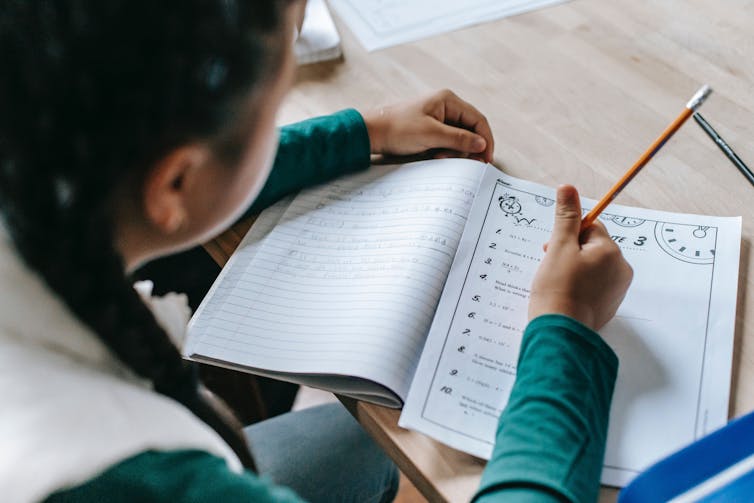
12 Oct Why are so many school students are falling behind?
How do we help those most at risk? ask researchers Melissa Cain and Joanne Quick
There is increasing concern about Australian students falling behind in numeracy and literacy.
NAPLAN results show that 16.2% of Year 3 students are at or below the national minimum standards in numeracy, and 12.9% are at or below the minimum standards in reading. By Year 9, this climbs to 20.4% and 25.1%, respectively.
The 2021 Early Development Census also found that 22% of Australian children were developmentally vulnerable in their first year of school.
Federal and state governments are currently working on the next National School Reform Agreement, which ties funding to school reforms and starts in 2025. The consultation paper released last month notes with concern:
too many students are starting school behind or are falling behind in minimum literacy and numeracy standards.
It also asks, what can schools do to help those most at risk of falling behind?
Why do students fall behind?
Students can fall behind for many reasons, and these can be complex.
This may be due to a student’s abilities, or perhaps they have a developmental issue or impairment. A student may have missed essential concepts through illness or changing schools. Or they may not have a home environment that helps them learn, such as healthy food, access to books and adequate sleep.
As the consultation paper notes, Aboriginal and Torres Strait Islander students, students in regional, rural and remote locations, students with disabilities, and students whose parents have low levels of educational attainment are three times more likely to fall below minimum standards.
The learning gap can also increase over time. Early difficulties with learning can quickly become compounded if they are not addressed.
Students who are behind can lose motivation to learn because they have missed essential concepts and find lessons frustrating. They can also start to exhibit challenging behaviours.
However, learning gaps do not necessarily increase. Australian research published this year shows effective teaching can compensate for early learning difficulties.
How do schools identify students?
Identifying students can happen informally and may occur at any age. At preschool, a teacher may notice a student has indistinct speech and recommend hearing testing, language support or both. The assessment of cognitive skills – such as literacy and numeracy – will usually happen when students begin school.
At school, teachers might observe children playing counting games and sharing out counters to identify which students have difficulty counting up to five.
More formal assessments might involve a young student reading a short list of real and made-up words. They can also include work samples or individual tests for older students. The results can be compared with others of their age or year level.
Teachers also look at students’ engagement in educational activities and school attendance. Pre-COVID figures from 2019 showed at least 25% of Australian students missed at least one month of school per year.
How can students catch up?
How a student catches up will depend on a number of factors. For those with a disability, an inclusion plan can make sure students have the right adjustments and supports to learn. This needs to be updated regularly.
For other students, the process of catching up might begin with meeting their basic needs through providing meals, uniforms and communication in home languages.
More generally, catching students up starts with the principle “know students and how they learn”. Teachers aim for a strength-based approach, which values the knowledge and skills students bring to school.
This draws from home knowledge, interests, and learning preferences to make the curriculum more engaging. For example, if a student has a great interest in sports, maths problems can incorporate data from games.
Students will not learn effectively if they do not feel valued, comfortable and safe.

Katerina Holmes/Pexels
Literacy and numeracy help
Approximately 20% of students require some additional teaching and support to acquire fundamental language, literacy and numeracy skills.
This may involve classroom, small group or individual support. It is easier and more effective to provide extra support early in students’ schooling, but older students can also benefit from intervention.
Due to teacher shortages, there has been an increase in teachers teaching out of their field of specialisation. We don’t yet know what impact this has had on intervention programs.
Most students can catch up
A 2023 study by the Australian Education Research Organisation and Monash University found approximately 95% of students should be able to meet academic benchmarks with quality classroom programs and research-supported interventions. But students with a history of learning difficulties should be carefully monitored as they may require additional support in the future.
About 5% of students will need more nuanced interventions and different teaching approaches. For example, a student with a physical disability might be disadvantaged when asked to write by hand. Working on a laptop instead of persisting with handwriting can help.
We need a more consistent approach
Australia has a national curriculum, but there are differences between what is taught and how it is taught across the states and territories. There are also considerable differences between schools.
This means students who move schools can be disadvantaged. Figures from 2016 show in New South Wales, 7% of all schoolchildren changed schools at least once during a year.
We need a more nationally consistent approach to the national curriculum. Jurisdictions and schools have varied philosophies, priorities and needs. But core standards around appropriate teaching approaches and effective interventions are possible.
There is also a need for increased sharing of information with parents and between schools. National student numbers could be used to track enrolment and core national assessment data.
Some parents and schools may be opposed to this idea for reasons of student privacy. Parents may want their children to have a “fresh start” if they change schools.
We acknowledge these concerns, but sharing key assessment data would reduce time re-assessing students in their new school and support strong teaching from day one.![]()
Melissa Cain, Senior Lecturer in Inclusive Education and Arts Education, Australian Catholic University and Joanne Quick, Senior Lecturer in Literacy, Australian Catholic University
Main Image: Anastasia Shuraeva/Pexels
This article is republished from The Conversation under a Creative Commons license. Read the original article.

